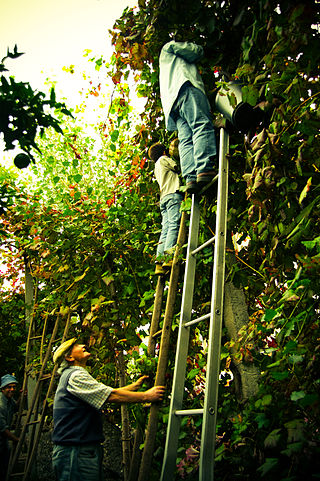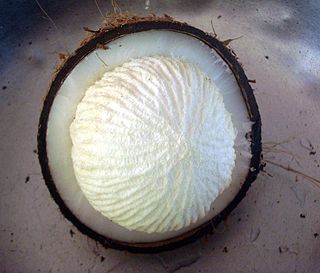
The Eixample is a district of Barcelona between the old city and what were once surrounding small towns, constructed in the 19th and early 20th centuries. Its population was 262,000 at the last census (2005).

Vinho Verde refers to Portuguese wine that originated in the historic Minho province in the far north of the country. The modern-day 'Vinho Verde' region, originally designated in 1908, includes the old Minho province plus adjacent areas to the south. In 1976, the old province was dissolved.

Candy apples are whole apples covered in a sugar candy coating, with a stick inserted as a handle. These are a common treat at fall festivals in Western culture in the Northern Hemisphere, such as Halloween and Guy Fawkes Night because these festivals occur in the wake of annual apple harvests. Although candy apples and caramel apples may seem similar, they are made using distinctly different processes.

Chã das Caldeiras is a small community of approximately 700 inhabitants in the crater of the volcano Pico do Fogo on the island of Fogo, Cape Verde. The village consists of two main neighborhoods: Portela and Bangaeira, founded in 1920 and 1917, respectively. At an elevation of about 1,700 meters, it is the highest village in Cape Verde. It is part of the municipality of Santa Catarina do Fogo. The main organizing body in the village is the Associação dos Agricultores de Chã, an agricultural cooperative that holds considerable sway over the local economy. Chã is the only area in Cape Verde that grows significant quantities of grapes and produces export-quality wines.

The Apple of Discord was a golden apple dropped by Eris, the goddess of strife, at the wedding of Peleus and Thetis in the Greek myth of the Judgement of Paris. It sparked a vanity-fueled dispute among Hera, Athena, and Aphrodite that eventually led to the Trojan War.

Chiles en nogada is a Mexican dish of poblano chiles stuffed with picadillo topped with a walnut-based cream sauce called nogada, pomegranate seeds and parsley, and it is typically served at room temperature. It is widely considered a national dish of Mexico.

A comparison of apples and oranges occurs when two items or groups of items are compared that cannot be practically compared, typically because of inherent or fundamental differences between the objects.

Fioravanti is a fruit-flavored, carbonated soft drink first sold in 1878 in Ecuador. It is notable for being one of the first soft drinks commercially sold. In 1991, it was acquired by The Coca-Cola Company.

Manzanita Sol is a brand of apple-flavored soft drinks owned by PepsiCo. It was created by two brothers, Ramon and Manuel Rodriguez Fonseca, who started Embotelladora El Sol after learning the trade from the father, a Spanish industrialist who arrived to Mexico in the 20th Century. The formula for Manzana Sol, a cider flavored drink, was registered in 1950, when the original factory was based in Mexico City's neighborhood of San Pedro de los Pinos, and later moved to Acoxpa 69, in Coapa. PepsiCo. bought the formula in the nineties. It originally included 6% of apple juice.
Jorge Velarde is a Contemporary Latin American painter from Ecuador. Velarde has been drawing and painting since he was a child. At the age of 15 Velarde knew that he was meant to be a painter.

Aquarius (アクエリアス) is an American-owned Japanese brand of sports drink manufactured by The Coca-Cola Company. It originated in 1978, and was first introduced in 1983 in Japan as a grapefruit-flavored sports drink, as a response to a competitor's brand of sports drink called Pocari Sweat. It was introduced in Spain and Portugal in 1991, and was the official drink of the 1992 Summer Olympics in Barcelona, 1994 Winter Olympics in Norway, 2008 Summer Olympics in Beijing, 2016 Summer Olympics in Rio de Janeiro, and the 2020 Summer Olympics. The brand has been heavily marketed by giving away free samples in sporting events.
Cerveceria Nacional Dominicana (CND), is the primary beer producer in the Dominican Republic, the company is owned by AmBev and Grupo León Jimenes. It was founded in 1929 by the American entrepreneur Charles H. Wanzer. It was the first brewery in the Dominican Republic and the largest in the Antilles and Central America with sales of 3.8 million hectoliters. It first released its major brand Presidente in 1935, and has since expanded to other brands such as Bohemia Especial, Presidente Light and Ambar. The first two are pilsener beers that fall in the category of lager beers, and the latter is the company's first incursion into dark beer. Its current brewery complex was opened in 1951. It employs 2,500 people and produces up to 500 million liters of beer.
Torremanzanas or La Torre de les Maçanes is a municipality in the comarca of Alacantí in the Valencian Community, Spain. It owes its name to an ancient Almohad fortification located in the upper part of the town. "Maçanes" means apples, the same than Spanish manzanas.
Manzana, a Spanish word meaning "apple" or "city block", may refer to:

Chilean cuisine stems mainly from the combination of traditional Spanish cuisine, Chilean Mapuche culture and local ingredients, with later important influences from other European cuisines, particularly from Germany, the United Kingdom and France. The food tradition and recipes in Chile are notable for the variety of flavours and ingredients, with the country's diverse geography and climate hosting a wide range of agricultural produce, fruits and vegetables. The long coastline and the peoples' relationship with the Pacific Ocean add an immense array of seafood to Chilean cuisine, with the country's waters home to unique species of fish, molluscs, crustaceans and algae, thanks to the oxygen-rich water carried in by the Humboldt Current. Chile is also one of the world's largest producers of wine and many Chilean recipes are enhanced and accompanied by local wines. The confection dulce de leche was invented in Chile and is one of the country's most notable contributions to world cuisine.

Zacatlán is a city and municipal seat of Zacatlán Municipality located in the Sierra Norte de Puebla region of Puebla in central Mexico. The area is known for its production of apples, other fruit, cider and fruit wines, which are promoted through the annual Feria de la Manzana and Festival de la Sidra. It is also home to the Relojes Centenario company, the first clock factory in Latin America and the builder of the city's double sided flower clock in the main square. The historic center of the city is filled with traditional houses with red tile roofs and Zacatlan was designated a “Pueblo Mágico” in 2011. Outside of the city proper, there is a significant indigenous population, the Piedras Encimadas Valley with its rock formations and various waterfalls and ravines.

Manzana Verde is the second album by Mexican pop singer Bibi Gaytán. It was released in 1994.

Oaxacan cuisine is a regional cuisine of Mexico, centered on the city of Oaxaca, the capital of the eponymous state located in southern Mexico. Oaxaca is one of the country's major gastronomic, historical, and gastro-historical centers whose cuisine is known internationally. Like the rest of Mexican cuisine, Oaxacan food is based on staples such as corn, beans, and chile peppers, but there is a great variety of other ingredients and food preparations due to the influence of the state's varied geography and indigenous cultures. Corn and many beans were first cultivated in Oaxaca. Well-known features of the cuisine include ingredients such as chocolate, Oaxaca cheese, mezcal, and grasshoppers (chapulines), with dishes such as tlayudas, Oaxacan-style tamales, and seven notable varieties of mole sauce. The cuisine has been praised and promoted by food experts such as Diana Kennedy and Rick Bayless and is part of the state's appeal for tourists.

Sprouted coconuts, also referred to as coconut sprouts, are the edible spherical sponge-like cotyledons of germinating coconuts. They have a crunchy watery texture with a slight sweetness. They are eaten in coconut-growing countries either as it is or as part of various dishes. They are not commercially produced. They are also known variously as coconut pearls, coconut embryos, coconut candy, coconut apples, coconut cotyledons or simply coconembryos or coconapples.















